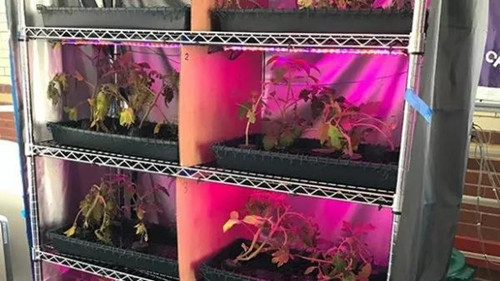In agriculture, vertical farming is seen as a fresh food solution for urban populations, helping to cut down on the processes needed for growth and transportation, thus reducing carbon footprint (a term used to describe the total greenhouse gas emissions caused by an individual or group). However, a student team from Carnegie Mellon University (CMU) views it as a way to boost basic nutrition in underprivileged areas. Using a simple device and LED lights, they are developing an affordable method that allows almost anyone to grow fresh food at home or within their community.

Poverty comes in many forms, but one of the most challenging is food poverty. People may lack the money to buy nutritious food, and even in wealthy countries, certain areas suffer from "nutrition poverty." In these places, pre-packaged or healthy food is scarce and expensive, leading to poor health and malnutrition.
To tackle this issue, a group of students from the Engineers Without Borders Association (EWB), led by Jack Ronayne, an undergraduate student from CMU’s Engineering and Public Policy (EPP) and Chemical Engineering (ChemE) programs, has turned to vertical farming as a practical solution. The idea is to empower people to grow their own fresh produce at home, improving access to nutritious food in low-income communities.
Kelvin Gregory, a civil and environmental engineering professor with EWB, explained, “Some regions have limited access to fresh food due to distance, freshness, or cost. We asked: Can we grow fresh fruits and vegetables right at home? Obviously, the system needs to be compact and efficient, which is why we’re focusing on vertical farming and using artificial lighting—something we’ve worked hard to improve.â€
While some vertical farms look like something out of a sci-fi movie, the CMU system is much simpler. It consists of metal shelves that can be bought from local stores and covered with black plastic tarps, creating a makeshift indoor greenhouse.
The system uses LED lights that can be programmed to flash at different speeds, allowing precise control over the amount of light plants receive. This helps optimize growth while using minimal energy.
Gregory added, “We're focused on energy efficiency. LEDs are more efficient than traditional bulbs, but their ability to turn on and off quickly gives us another advantage. By adjusting the flashing speed, we can determine exactly how much light plants need to grow well without wasting energy.â€
Additionally, the system is easy to scale. The current setup includes 40 tomato plants, and the team hopes to expand it for larger community farms in the future.
Ultimately, the goal is to make fresh, healthy food accessible to everyone, regardless of where they live or their financial situation.
**Editor: Yan Zhixiang**
Harvester Guide Wheel,Conveyor Roller Guide,Ceramic Guide Roller,Grade Tractor Tires
Changzhou Youeryou Trading Co., Ltd. , https://www.farmpartssupplier.com
